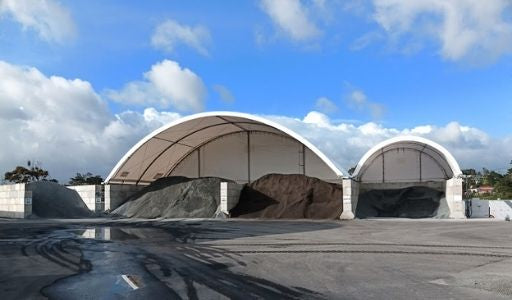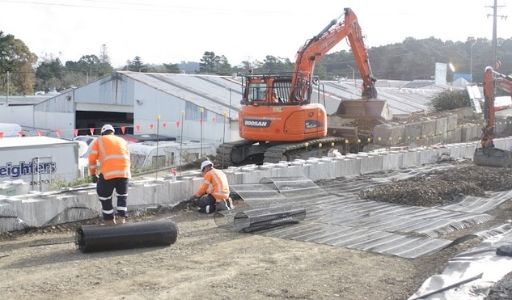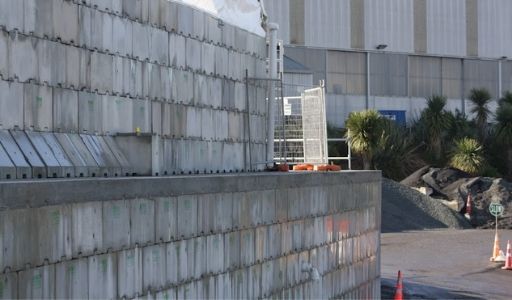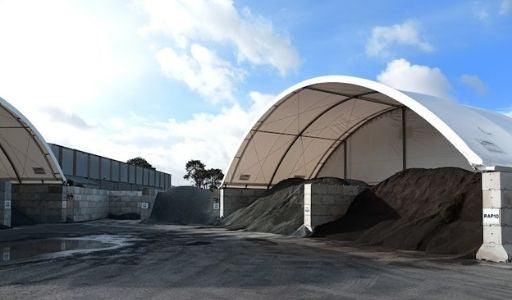Fulton Hogan is one of New Zealand’s leading civil contractors. They have a deep commitment to building the infrastructure that powers economic growth. Most recently, this has meant they’ve expanded asphalt production at their Silverdale plant in the rapidly expanding area of North Auckland. Key to asphalt production is aggregate storage. Envirocon’s Interbloc wall system was used to build flexible, durable, and safe storage bunkers.
When additional aggregate storage was required at Fulton Hogan’s asphalt manufacturing plant in Silverdale, the company specified Interbloc. It was a no-brainer - Fulton Hogan has extensive experience utilising the Interbloc system throughout the country for similar purposes.
12 bins of varying sizes were constructed from the Interbloc precast wall system, giving an additional capacity of 1,750m3 of aggregate storage, equal to 2,750 tonnes of material.

To complicate matters, the bins had to be built at the top of a 3m high retaining wall on three sides. The combined weight of the filled bins and the backfill material meant that engineers needed to be satisfied that the retaining walls would be able to handle such loads, especially since unsuitable base soil meant retaining walls had failed in the past. Interbloc showed its unique versatility by allowing high surcharge capacity reinforced earth walls to be built by simply casting geogrid into the blocks during the manufacturing process.
“Due to the steep topography of the landscape, a retaining wall was constructed out of Interblocs to provide a level surface for the aggregate bins to be built on,” explained Fulton Hogan's Project Engineer Oli Brooks. “Geogrid was used in the backfill behind the retaining wall, and tied into the blocks. Granular backfill (DQ65 which has a compacted dry density of 2.14tonnes/m3 ) was then placed and compacted in 150-200mm layers, with geogrid installed at each Interbloc row ", explains Envirocon’s Peter Fowler.

The asphalt plant had to remain in production throughout the expansion process. As a result, the 20-year-old storage yard had to be deconstructed in stages. This meant temporary bins were built using Interblocs, in a different area of the yard, to accommodate some of the material while the full operation of the plant continued. These blocks were then re-used at the final bin sites.
This project was the first to use the new Interbloc base block for the storage bins. The combined forces of the product, the height required to store materials in the footprint available - and to provide support for a fixed roof – meant base blocks could spread the wall load over a bigger footprint, delivering greater design efficiency.

(Holding the aggregate bins (with the new Interbloc Base Block) up is a 3m long retaining wall)
All bins were assembled on-site, and Brooks felt the process was “pretty straightforward - the 3D drawings helped significantly,” he said. This was critical as the density of stored aggregates varied between 1.4 to 2.3 tonnes/m3.
“The new layout and storage volumes have removed the safety and storage problems, and future-proofed it for many years to come,” said Peter Fowler proudly.

The Interbloc system easily absorbed the loadings required of such a structure, and the team found its construction very straightforward.
The number of 3D drawings of the block layouts supplied by Envirocon really helped the team visualise what they were building, said Brooks. “This made the whole process go a lot more smoothly.”
Brooks particularly praised the support received from Envirocon during the build. “The Interbloc team, specifically Peter and Cole, have been very responsive and accommodating to design changes and last-minute requests,” said Brooks. “And the 3D drawings of the block layouts were very helpful for the site team to visualise what they were building.”









